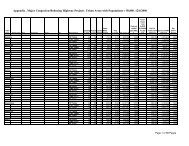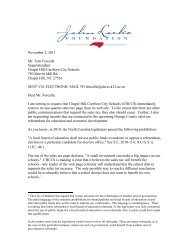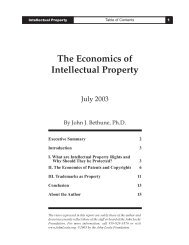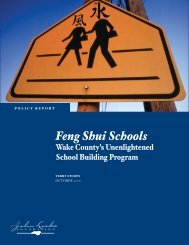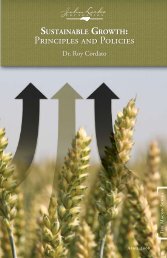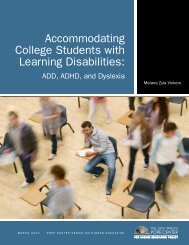Flex Growth - John Locke Foundation
Flex Growth - John Locke Foundation
Flex Growth - John Locke Foundation
Create successful ePaper yourself
Turn your PDF publications into a flip-book with our unique Google optimized e-Paper software.
FLEX GROWTH<br />
5<br />
A. Most Americans prefer the suburbs<br />
At its most basic level, Smart <strong>Growth</strong> is a backward-looking<br />
economic development model. It looks<br />
back a century to the densely built, rail transit dependent<br />
cities of the late 19th and early 20th centuries as<br />
its inspiration. Smart <strong>Growth</strong> advocates assume that<br />
this earlier vision is how most Americans want to live,<br />
that we as a people have simply been deluded by automobile<br />
manufacturers and real estate agents into giving<br />
up apartments and condos in high-rise buildings along<br />
subways and light-rail lines in favor of detached houses<br />
on quarter-acre lots out in the suburbs. In this, Smart<br />
<strong>Growth</strong> advocates are wrong.<br />
To be sure, a percentage of Americans do want to<br />
live in densely-built urban areas. The number, though,<br />
is relatively small and constant. 4 Over the past decade,<br />
nearly 80 percent of housing built in the country’s 51<br />
metropolitan areas with populations of over 1,000,000<br />
were single-family, detached houses. 5<br />
It is often argued that Millennials — those born between<br />
1982 and 2003 — are different. There is scant evidence<br />
to support this conclusion. A large plurality (43<br />
percent) of Millennials say that suburbs are an “ideal<br />
place to live.” 6 And many of those who currently enjoy<br />
an urban lifestyle will move to the suburbs to settle<br />
down and have kids — or to settle down and have their<br />
parents move in after they retire. Or both, as the number<br />
of multi-generational households grows. 7<br />
B. Smart <strong>Growth</strong> misdefines efficiency…<br />
One of the more common arguments against<br />
“sprawl” is that it is somehow “inefficient.” Of course,<br />
the key is how one defines the concept of “efficiency.”<br />
The typical environmentalist definition regards lowdensity<br />
suburban housing as inefficient because relatively<br />
few people live on an acre of land. A productive<br />
resource, land, is not used as intensely as it could be;<br />
with denser development, more families could live in<br />
the same amount of space.<br />
While this may seem a logical definition of “efficiency,”<br />
it is in fact far off the mark. Economic theory<br />
tells us that efficiency — which involves the best allocation<br />
of resources within society — is associated with<br />
people acting to maximize their personal happiness and<br />
involves the benefits of something balancing with the<br />
costs of that product or item.<br />
Unfortunately, the environmentalist definition of<br />
efficiency has nothing to do with making people happy,<br />
but everything to do with maximizing production<br />
with the minimum of a particular resource. The two approaches<br />
are fundamentally different.<br />
C. …and is shown not to cost less<br />
A more sophisticated version of this inefficiency argument<br />
contends that sprawl is undesirable as it imposes<br />
additional costs upon society as compared to denser<br />
forms of development (i.e. Smart <strong>Growth</strong>).<br />
In general, it is asserted by Smart <strong>Growth</strong> advocates<br />
that lower local government costs are associated with<br />
higher population densities, lower rates of population<br />
growth, and older municipalities. Whether this is true<br />
or not is an empirical question that Wendell Cox and<br />
Joshua Utt addressed in a 2004 paper for the Heritage<br />
<strong>Foundation</strong>. 8 Their analysis found “no practically significant<br />
difference in expenditures per capita between<br />
the more sprawling and less sprawling communities.” 9<br />
What the two researchers did find was that differences<br />
in employee compensation explained most of the<br />
variation in municipal expenditures. As Cox and Utt<br />
noted, “It seems much more likely that the differences<br />
in municipal expenditures per capita are the result of<br />
political, rather than economic, factors — especially the<br />
influence of special interests.” 10<br />
Writing in the Journal of the American Planning Association,<br />
four British researchers reached similar conclusions<br />
about the impact of Smart <strong>Growth</strong> in a 2012<br />
paper. 11 Marcial H. Echenique, Anthony J. Hargreaves,<br />
Gordon Mitchell, and Anil Namdeo found that Smart<br />
<strong>Growth</strong> was not inherently preferable to less dense land<br />
use patterns based on an analysis of the experiences of<br />
three British areas. The authors concluded that “Smart<br />
growth principles should not unquestioningly promote<br />
increasing levels of compaction on the basis of reducing<br />
energy consumption without also considering its potential<br />
negative consequences. In many cases, the potential<br />
socioeconomic consequences of less housing choice,<br />
P O L I C Y R E P O R T



